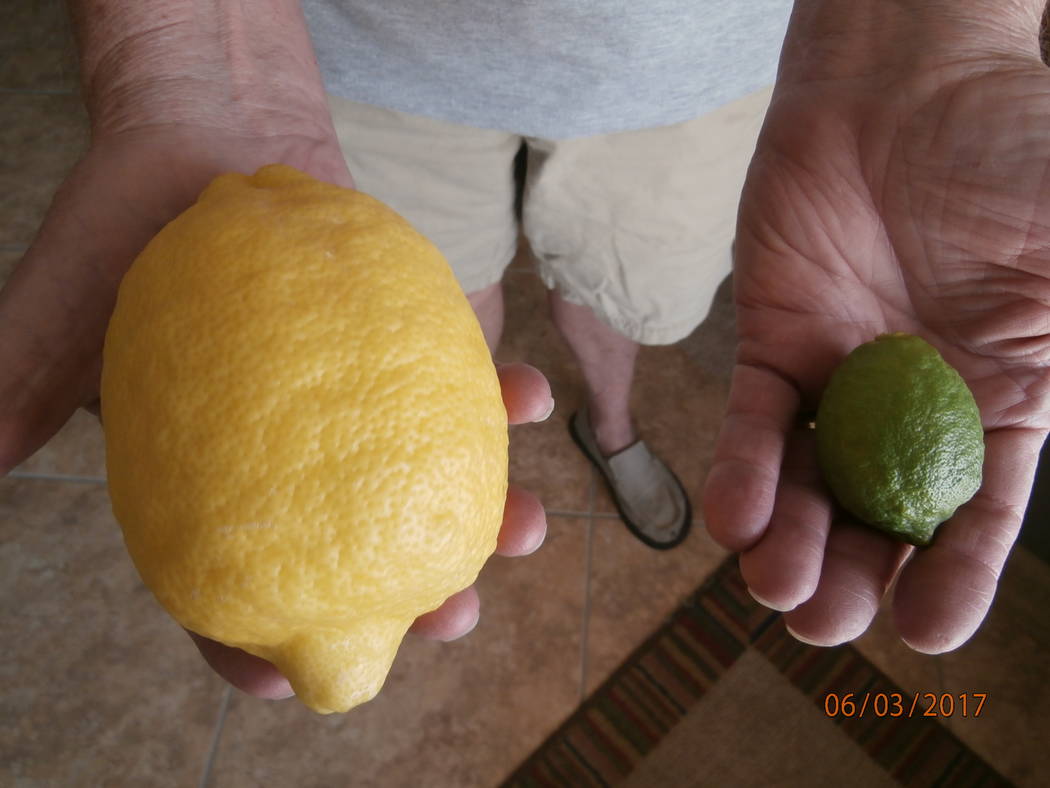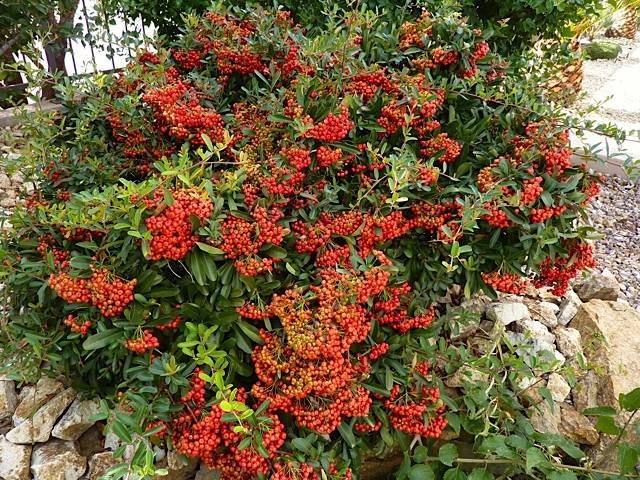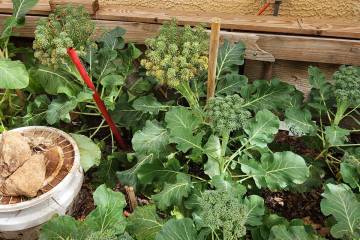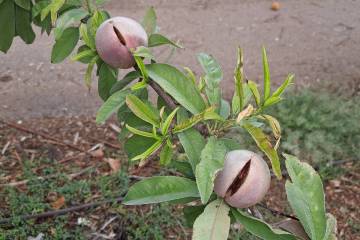Ponderosa, Meyer are not true lemons
Q: We have a 30-foot-tall lemon tree planted in late 2006. This tree produces large fruit, averaging 15 ounces to more than a pound. I consider this tree to be perpetual as it flowers fruit and maintains a crop in development at the same time. My question is, do we pick the ripe fruit or let them fall as they may?
A: This is most likely a Ponderosa lemon that is known to potentially flower 12 months out of the year under the right circumstances. You must have the right circumstances but, sorry, Ponderosa — just like Meyer — is not a true lemon.
Ponderosa is a lemon crossed with a citron. This is probably why it flowers so much. Meyer is a cross between a lemon and an orange. This is the reason the fruit of the Meyer tree is round with an orange-yellow rind color rather than the more traditional lemon yellow. Meyers also are sweeter than a true lemon.
True lemons that have been grown in the valley include Eureka and Lisbon. Eureka is less tolerant of freezing weather than the others, including Meyer, but it is nearly seedless — a big plus.
If you want a true lemon experience. then rough-skinned Eureka and big-nippled Lisbon would be good choices. Eureka is probably the favorite of the lemons. Both are lemony sour.
Pick Ponderosa fruit as it matures even if it’s during warm weather. Maturing fruit in warm weather will turn from a dark green to a lighter green. It is more likely to turn yellow if it matures during cold weather. Commercially, lemons may be treated with ethylene gas to make them consistently very yellow for the American market.
Be on your toes to see the difference in warm weather. Even if they aren’t yellow, they can still be used. They will not keep on the tree for very long when the weather is warm. During cold weather, they can stay on the tree much longer and maintain their quality.
Q: We have a pyracantha shrub with the leaves turning brown. It is being watered by drip system three days a week for one hour. It has a lot of berries but no blooms this year. Help?
A: Check for borers. Pyracantha or firethorn can get borers, and the leaves will die on a single branch or two. The plant’s leaves should shade the trunk and large limbs, or borers will be a big challenge due to sunburn to these areas.
Poor pruning practices that leave the shrub open to intense sunlight also will lead to borer damage. Here is where hedge pruning, or shearing, can be a big advantage for this plant.
Make sure it is getting enough water as it gets bigger. Add an emitter to increase the amount of water it needs as it gets larger.
Prune out the dead branch or branches. If this leaves a big void or looks bad, then replace it. Improve the soil at planting with soil amendments and avoid rock mulch on the soil surface if possible.
Woodchip mulch will be a better choice. Rock mulch makes it much hotter in the canopy and might increase the chance of borers.
Q: We recently bought a white flowering wisteria. Within the past few days, we are seeing almost perfectly round holes in the leaves. We do not see anything on the plant itself. Any idea what this is and how we can cure it?
A: This is the work of the female leaf-cutter bees harvesting soft leaf tissue for packing her egg laying spots. Harvested leaf tissue serves as food for her babies when they emerge.
I ask people to tolerate their activities since they are good pollenizers for fruit and vegetables. In my opinion, they are not worth spraying pesticides to control them.
These are solitary bees, stingless and do not build hives or make honey — unlike the more common honeybees, which are social and live together communally.
These solitary bees lay eggs in cracks and crevices in rock, wood or anywhere they can find; all they need is a hole or crack about ⅜ inch in size. To my knowledge, they do not build nests in the ground as some solitary bees do.
There is a way to reduce their numbers without pesticides. Buy a box of soda straws. Drill holes in a piece of wood at least 4 inches deep. Make them just large enough so the soda straws will slide into them.
Cut off lengths of soda straws so they slide inside the holes. Paper straws are better than plastic straws. In the spring, pull out the straws and dispose of them.
It will not eliminate the bees entirely but reduces some of their population. Otherwise, plant lots of other plants they enjoy as well such as basil and spread out the damage.
Q: We have a 19-year-old Blue Ghost eucalyptus on the north border of our backyard. It is about 50 to 60 feet tall, and we’re concerned about toppling with high winds. What do you think?
A: I am not as concerned about it toppling over as I am about another problem for this particular tree. It is called SBD. It happens most commonly with the Blue Ghost eucalyptus. I am particularly unhappy because this is one of my favorites of all the eucalyptus and one of the most cold- and heat-tolerant.
Since a death incident at the Royal Botanic Garden in Kew, England, involving summer branch dieback/sudden branch dieback/sudden branch drop (SBD) and a large eucalyptus tree, I don’t think I would risk sitting under one or want one on my property.
I have never experienced SB, but my understanding is that a large limb can drop from the tree with no warning. A large cracking noise is heard and a large branch drops suddenly. I know it sounds incredible.
Many Californians were glad to see most of the eucalyptus gone from their public and private landscapes. Eucalyptus, in general, are very drought tolerant and have been used throughout the world for reforestation. This tree has become a problem in parts of dry Africa.
The eucalyptus borer, an insect found primarily in California, has also led to its decline and rejection by many municipalities and arborists. Having eucalyptus on the property, particularly Blue Ghost eucalyptus, is a risk. I can’t tell you what to do on your property, but if it were mine, I would remove it.
Q: We found this creature on a neighbor’s grapevine yesterday and wasn’t sure what it was or the best way to eliminate it. Originally, I thought it was a tomato hornworm, but it has no horn and it was on a grape leaf.
A: Very good detective work. Yes, this is a close relative to the very large hornworm and doing similar damage to grape plants — eating the leaves. Some of these so-called hornworms are minus the horn but have an “eyespot” coloration where the horn would be instead.
I think we can still call them hornworms but with a wink. The adult of this larva is a large moth, similar to the dusk-flying hummingbird or sphinx moth of the hornworm.
Hornworms are a general pest on many plants in the tomato family, but some types, such as this hornless species, can be found feeding on the new foliage of grapes. They can be small in number but eat a lot. They are difficult to find because their green coloring matches the leaves perfectly.
Wait for a calm day and look for isolated leaf and stem movement different from movement due to wind. This movement, because they are heavy, is a dead giveaway for their location.
Hornworms, in general, irradiate a green color at night under a black light. So, if you are using a black light to track down bark scorpions in the yard, you can use it for this insect pest as well.
Hand pick them or use your pruning shears. Otherwise, sprays of Bt or Spinosad on the leaves will take care of them. Bt is less of a problem for bees if bees are in the vicinity because of flowers.
Bob Morris is a horticulture expert and professor emeritus for the University of Nevada, Las Vegas. Visit his blog at xtremehorticulture.blogspot.com. Send questions to Extremehort@aol.com.
























